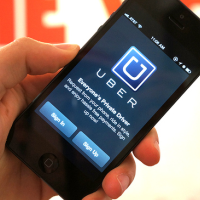Ride-Sharing Drives S.F. Taxi Industry to the Brink

In almost less time than it used to take to hail a cab in San Francisco, the taxicab industry there has collapsed in the face of competition from ride-sharing companies.
A report (pdf) from the San Francisco Municipal Transportation Agency (SFMTA) indicated that taxi drivers picked up 65% fewer fares in July than in March 2012, a drop from 1,424 fares per car per month to 504. The city has about 9,000 cab drivers.
Just about every publication is calling it the Uber Effect, in honor of the Bay Area smartphone startup that tapped into the sharing economy in 2012 and rewrote the business model for getting people from here to there. Uber, the largest ride-sharing company, and other companies like it deputized an army of full- and part-time drivers in their own vehicles who respond quickly via computer app and immediately took rides from cabbies.
Uber is now available in more than 100 cities in 35 countries. It was recently valued at around $17 billion.
Ride-sharing companies cut expenses incurred by traditional brick-and-mortar businesses by claiming they aren’t covered by transportation regulations regarding insurance, benefits, taxes, safety, inspections and other encumbrances.
Their first forays into the marketplace in California and elsewhere were greeted with enthusiasm by many customers and dismay by local and state government, who sought to figure out a regulatory framework for transportation companies that preferred to think of themselves as just app creators.
But even as they battled in courts, city halls and state houses, ride-sharing companies continued to quickly attract taxi customers. While the city of San Francisco has numbers on declines in the industry it closely regulates, it has nothing on what must be substantial gains in the industry it casually oversees.
After an initial response by the taxi industry focused on complaining about the unfair playing field they were forced to compete on, companies began to adopt some of the competition’s technology. The report from SFMTA said cab companies had updated 80% of their fleets to accept Flywheel and 60% to take Curb, both mobile taxi-hailing apps. The report cited a 3.5-minute average improvement in pick-up times from cabs that used Flywheel, and said a bunch more cabs were accepting credit cards.
The taxi industry continues to press for breaks from regulatory fees and procedures while pressing lawmakers to impose costly, standard transportation industry requirements on ride-sharing. The latter goal gets tougher by the day.
San Francisco Business Journal writer Allen Young said Assembly Bill 2293, signed by Governor Brown last week, displayed the new power of the fledgling industry which, in a legislative blitz, reduced insurance requirements on ride-sharing companies to a fraction of the original proposal.
Another bill, AB 612, which Uber called “a flagrant attempt to stymie innovation and competition by an antiquated industry,” would have required criminal background checks for drivers. It died in the Assembly.
–Ken Broder
To Learn More:
The Uber Effect: How San Francisco's Cab Use Dropped 65-Percent (by Sean Buckley, Engadget)
Ride Services Decimate S.F. Taxi Industry's Business (by Michael Cabanatuan, San Francisco Chronicle)
Report Says SF Taxis Suffering Greatly (by Jessica Kwong, San Francisco Examiner)
Uber, Lyft, Sidecar Drive Average Taxi Usage Down 65% in S.F. (by Patrick Hoge, San Francisco Business Times)
Governor Signs Much-Debated Ridesharing Insurance Bill (by Allen Young, Sacramento Business Journal)
Taxis and Accessible Services Division: Status of Taxi Industry (San Francisco Municipal Transportation Authority) (pdf)
- Top Stories
- Controversies
- Where is the Money Going?
- California and the Nation
- Appointments and Resignations
- Unusual News
- Latest News
- California Forbids U.S. Immigration Agents from Pretending to be Police
- California Lawmakers Urged to Strip “Self-Dealing” Tax Board of Its Duties
- Big Oil’s Grip on California
- Santa Cruz Police See Homeland Security Betrayal in Use of Gang Roundup as Cover for Immigration Raid
- Oil Companies Face Deadline to Stop Polluting California Groundwater





